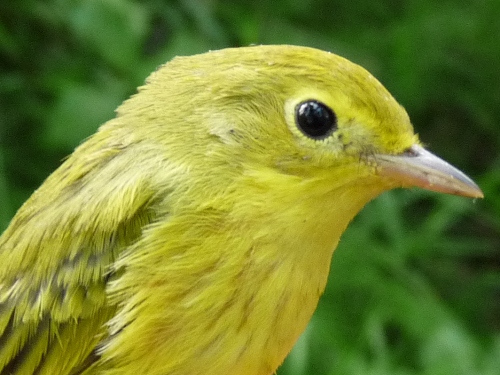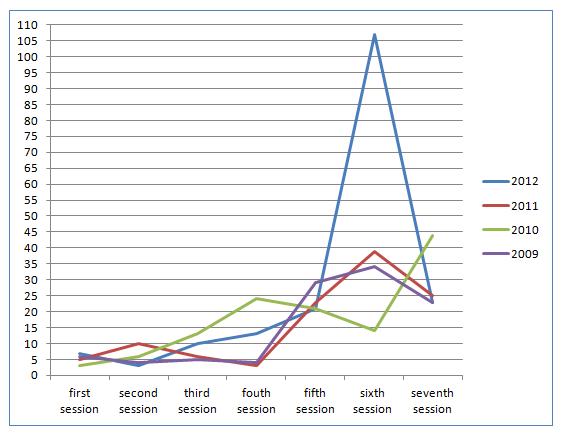Summer 2012 (June 6 – July 31)
PICTURE OF THE SEASON: |
|
|
| MAPS SEASON | NEST BANDING | 2011 TOTAL | SITE TOTAL | |
|---|---|---|---|---|
| # birds (and species) banded | 184 (31) | 13 (2) | 1265 (70) | 37016 (108) |
| # birds (and species) repeat | 26 (8) | — | 338 (33) | 6751 (69) |
| # birds (and species) return | 10 (5) | — | 139 (20) | 1100 (38) |
| # species observed | 56 | — | 144 | 207 |
| # net hours | 378.0 | — | 3259.8 | 62358.9 |
| # birds banded / 100 net hours | 48.7 | — | 38.8 | 59.4 |
Note: table does not include nocturnal banding (owls)
Banders-in-charge: Simon Duval, Gay Gruner, James Junda
Assistants: Jean Demers, Mary Robichaud, Clémence Soulard, Matthew Von Bornhoft
Monitoring Avian Productivity and Survivorship (MAPS), Summer 2012
For the fourth year in a row, MBO’s summer program followed the MAPS protocol. It is a breeding-season study, wherein banding takes place on a single day during each of seven consecutive ten-day periods falling within MBO’s summer season of June 6 to July 31. The first five periods coincide with the “adult superperiod” (typically dominated by breeding adults) and the last two with the “young superperiod” (usually dominated by juveniles). To reduce overlap with our migration monitoring programs, we do not use our regular set of 16 nets; rather we use nine nets placed around the southern end of Stoneycroft Pond. In addition to operating mist nets, observers gather breeding bird evidence on all species heard or seen during each banding day.
|
|
This year we banded a record 184 individuals of 31 species, by far the highest total in our four years of operating the MAPS program (another 13 nestlings from nest boxes were banded – 9 Tree Swallows and 4 House Wrens – bringing the overall summer total to 197). However, this year’s total was overwhelmingly influenced by a very sixth session on July 23, with 107 birds banded, including an unprecedented 56 Yellow Warblers. As always, most of the birds banded during the "young superperiod" were juveniles, but in this case, numbers were clearly inflated by early migrating Yellow Warblers, as even in the best of seasons there are not that many residents and offspring at MBO in summer. But even if these Yellow Warblers are assumed to be mostly migrants, the season total would still be higher than in either 2010 or 2011, and comparable to the 156 birds banded during MAPS in 2009.
| # individuals banded [rank in 2010] | mean # individuals observed |
|---|---|
| 1. Yellow Warbler (61) [4] | 1. Yellow Warbler (12) [8] |
| 2. Song Sparrow (26) [1] | 2. Black-capped Chickadee (7) [2] |
| 3. American Robin (18) [2] | 2. Red-winged Blackbird (7) [1] |
| 4. Black-capped Chickadee (13) [6] | 4. Song Sparrow (6) [5] |
| 5. Warbling Vireo (8) [-] | 5. American Robin (5) [4] |
| 5. Red-eyed Vireo (8) [3] | 6. Common Yellowthroat (4) [-] |
| 5. Common Yellowthroat (8) [9] | 6. Cedar Waxwing (4) [2] |
| 8. Swamp Sparrow (5) [9] | 6. American Goldfinch (4) [5] |
| 8. Red-winged Blackbird (5) [-] | 9. American Crow (3) [5] |
| 10. Cedar Waxwing (4) [-] | 10. Northern Cardinal (2) [-] |
Five of the ten most frequently banded species this year were also in the previous lists for 2009 through 2011: Song Sparrow, American Robin, Red-eyed Vireo, Yellow Warbler and Black-capped Chickadee. Although Warbling Vireo has been present as a breeder each year, we had only previously banded 2 in summer, so the jump to 8 this year was a surprise, and brought the species into the top ten for the first time. Overshadowed by the wave of Yellow Warblers is the strong showing by Song Sparrow – a new summer record, well beyond the 20 banded during MAPS in 2009. The biggest drop compared to last year was Baltimore Oriole, which ranked fifth last year with 9 individuals last year, but this summer just a single individual was banded.
Five species were banded for the first time ever in summer: Red-breasted Nuthatch, Brown Thrasher, Chipping Sparrow, Brown-headed Cowbird, and Purple Finch. The thrasher, sparrow, and cowbird are regular summer residents that have each been observed in 6 of 7 previous summers at MBO. The other two species are scarcer in summer, with the nuthatch previously recorded only once each in 2007 and 2008, and the finch just once in 2010. The count of species banded at MBO in summer now stands at 43.
This year we had 10 returns (birds banded in previous years) of five species: Common Yellowthroat, Red-eyed Vireo, Black-capped Chickadee, Veery, and Swamp Sparrow. In addition, we had 26 repeats (birds banded or last recaptured within the previous three months) of eight species: Song Sparrow, Black-capped Chickadee, Yellow Warbler, Red-winged Blackbird, Common Yellowthroat, Red-eyed Vireo, Warbling Vireo and Gray Catbird.
Over the seven sessions, 56 species were observed, slightly above average for the 4 years of MAPS. Of these, just 9 were recorded on each visit: Warbling Vireo, Red-eyed Vireo, Black-capped Chickadee, American Robin, Cedar Waxwing, Yellow Warbler, Common Yellowthroat, Song Sparrow, and Baltimore Oriole. Another 8 were observed during 6 of the 7 sessions: Downy Woodpecker, American Crow, House Wren, Gray Catbird, Swamp Sparrow, Northern Cardinal, Red-winged Blackbird, and American Goldfinch. Collectively, these represent most of the common breeding birds at MBO.
Because the focus of MAPS is on recording data from captured birds and there is extra urgency in processing breeding adults quickly, there is somewhat less emphasis on observations than in other seasons. Nevertheless, the results reflect a fair degree of consistency between years, as eight of this year’s top ten species were also in last year’s top ten. Worth noting is that if the July 23 influx is removed, Yellow Warbler would tumble to sixth place for this summer. No species were observed for the first time in summer, so the cumulative total for the season remains 100.
The number of birds banded during MAPS is relatively modest compared to other programs at MBO, and between heat and mosquitoes, the conditions are often somewhat uncomfortable. However, part of the strength of MAPS is that it is a continent-wide program coordinated by the Institute for Bird Populations, allowing for local results to be part of a much bigger picture. Among other things, MAPS data can be used to model vital rates (i.e. reproduction and survival) for each species, at a variety of geographic scales. We therefore plan to continue with MAPS again next summer. For now though, we look forward to more migrants coming through MBO as part of the Fall Migration Monitoring Program.
 The totals this summer were inflated by an unprecedented influx of hatch-year Yellow Warblers on July 23 – more in one day than in any previous entire season!
The totals this summer were inflated by an unprecedented influx of hatch-year Yellow Warblers on July 23 – more in one day than in any previous entire season! A four-year comparison of the number of individuals banded per session during the MBO MAPS season, showing a generally consistent pattern except for a dramatic spike in the sixth session for 2012.
A four-year comparison of the number of individuals banded per session during the MBO MAPS season, showing a generally consistent pattern except for a dramatic spike in the sixth session for 2012.